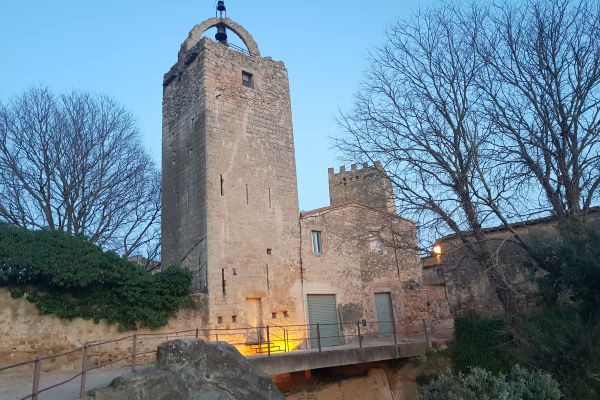Visit Tower of the Hours
Visit the Heritage of Peratallada, Tower of the Hours
The Torre de las Horas de Torre de las Horas (13th-15th centuries) is one of the most representative and best preserved of the medieval defensive system of Peratallada.
Between 2017 and 2021 it underwent an important restoration and adaptation process to make it visitable, which was promoted by the Forallac City Council and the Girona Provincial Council, in collaboration with the Generalitat of Catalonia.
What can we see?
- Interior structure of a medieval best tower.
- Masonry and loopholes recovered.
- Restitution of the missing central floor.
- Monumental mechanical clock from the early twentieth century.
- Skill viewpoint on the deck, from where you can see spectacular views of the medieval complex, its surroundings and a large part of the Empordanet.
Visiting calendar
- June: weekends 19 and 20, 26 and 27.
- July and August: every day.
- September: weekends 4 and 5, 11 and 12.
- Peratallada Medieval Fair: October 2 and 3.
Visiting Hours
From 9:30 a.m. to 1:30 p.m. and from 5:00 p.m. to 9:00 p.m.
Visit price
The price of tickets is 3 euros and must be purchased on the website visitperatallada.cat
Maximum 10 people per 30 min visit.
Architectural evolution
Originally, the Tower of the Hours was surrounded on three of its sides by a defensive moat dug into the rock, while the fourth was open towards the interior of the fortification. Several elongated loopholes were opened in its walls, divided into three combat levels (one lower than the same level, another in the middle supported on an arcade -now disappeared- and wooden beams and, finally, a terrace, located on a large pointed arch , surely crowned with battlements). Access to the various floors was through an internal staircase made of perishable materials (wood or rope).
Throughout its history, the construction has undergone several reforms that have changed its appearance. In the first place, on the west façade, a large lintelled portal was opened at the end of medieval times, still visible. Due to the fact that this portal is at a much higher level than the current street, like the loopholes on the lower floor, we must think that both the exterior and the interior of the tower were lowered at a later date. Possibly, this happened when the current street was opened and the adjoining house was built, which led to the amortization of the aforementioned portal (possibly in the middle of the 19th century).
Later, the set was modified to accommodate the clock that gives the tower its name. During this intervention, the upper terrace was removed and a closed house was built to install the clock's machinery, crowned by a small bell tower. This performance also involved breaking the Gothic archway to pass the counterweights of the clock. Likewise, to have easy access, a door was opened to the base and a work ladder was installed.
The last intervention detected in the tower and the most problematic date from the middle of the 20th century, when a large portal was opened in the annexed house. This work will destabilize it, since its base was dangerously shaved, which caused the appearance of important cracks, which have been repaired in the last restoration.
The Villa Clock
The monumental clock of the Tower of the Hours was manufactured at the beginning of the 20th century, in Morez, a small town in the French region of the Jura with a great watchmaking tradition. Specifically, it was built by L. TERRAILLON and J. Petitjean, two renowned professionals from the region, who partnered in 1914.
The mechanism has three running gear (hence its triangular arrangement), which allows to offer the chime of the hours, the repetition of the hours and a half with two bells (these are older and were reused).
The largest bell, which is 67 centimeters in diameter and 60 centimeters high, is dated 1800 and weighs about 180 kilograms. The small bell, which is 46 centimeters in diameter and 40 in height, is dated 1798 and weighs about 55 kilograms. The first was in charge of playing the hours, while the second the quarters. The watch has autonomy (winding) for a week and the reassembly of the weights that move the machinery is done manually.













